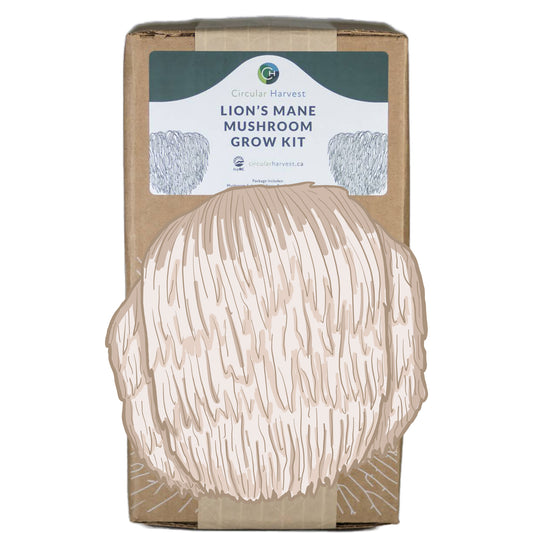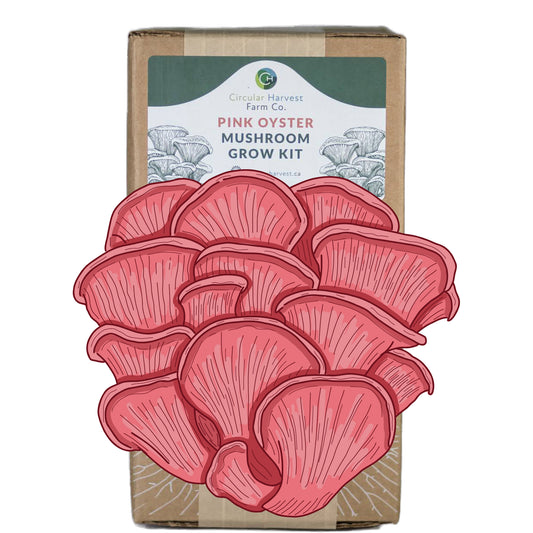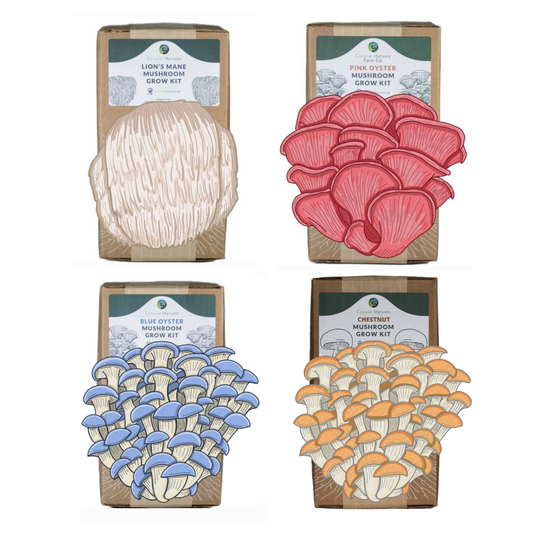Commercial growing can be a great side hustle or a full-time job. There are many different ways to go about starting a mushroom farm and we won’t discuss them all but we will touch on some common ways to start and build their first larger scale farm.
Before deciding to start any business, including a mushroom business, you need to make sure there is a demand for your product. We highly encourage people to do market research before deciding to invest in building a big operation. If you are already a hobby grower and have a grow tent, maximising that space is a great way to start. If you are brand new to mushroom growing, we advise you to check out our (how to build a Mushroom Grow Tent) Blog first.
When doing your market research, you will need to decide where you will sell the mushrooms and what varieties you will grow. Selling to restaurants, grocery stores, farmers markets or any other outlets is a good place to start. You should go to these locations and try and get purchase orders (verbal or written commitment) from them so you can see how much you can sell. You should ask
- What mushroom varieties they would want
- What quantity they would order
- What price they will pay (do market research on what the varieties you are going to sell are selling for locally).
- How deliveries will work (when and how they want them delivered)
- What marketing material they need from you.
If you are already a hobby grower, bringing in live samples is a great way to ensure sales. Once you have gathered all your potential orders and understand how many mushrooms you will need on a weekly basis it is time to decide what kind of farm you want to operate.
There are different types of farms that exist in the gourmet mushroom industry.
-
Substrate and Spawn Farms
- Large facilities producing for other farms to fruit mushrooms.
PRO’s:
- Invest in one specific segment of the industry to specialize
- Control over the quality of spawn
- Operate on a large scale
CON’s
- Big investment in equipment
- Need lots of clients to be economical
- Expertise needed to produce and maintain spawn.
- Risk of contamination is on you. (big learning curve).
-
Fruiting Farms
- Only invest in a grow room and buy their substrate blocks to grow.
PRO’s
- Low investment to start growing mushrooms
- Don’t need to be an expert to fruit great mushrooms
- Less labour intensive
- Clear cost structure for financial planning
- Can ramp up and down production easily
- Contamination losses are on the producer not you.
CON’s
- Limited control over the spawn production
- Smaller profit margins (Unless pricing strategically)
- Have to grow using the method supplied to you (bags usually)
-
Full Farm (Doing spawn and Fruiting)
- Big or small farms that want to do the whole process themselves.
PRO’s
- Full control over process
- Larger profit margins
- Can grow with any method you want
CON’s
- Very Labour intensive
- High start up costs
- Lot’s of expertise needed
- Risk of contamination is on you
Now a lot of new farmers decide to go the fruiting farm route due to its low start-up costs and not needing to be an expert in the field to start. Some DYI people love doing the whole process themselves but if you are not committed to being married to your farm and not wanting to deal with the headaches of contamination and other operational mishaps bound to happen as you learn, than we suggest you steer clear from doing the whole process yourself. Now, Circular Harvest is a substrate/spawn farm, so we supply other farms with mushroom grow blocks. It is very difficult to go this route as a beginner because you need to ensure high quality spawn to your customers and be at a large enough scale to supply blocks at a low enough cost to make it economical for the other farmers to buy from you. So we highly suggest starting as a fruiting farm first. You can check out our substrate supply program (here) or do research on local farms near you who could supply you.
Once you have decided what kind of mushroom farm you want to start, you will need to decide what method you want use to grow. Will you grow on sawdust or straw? Will you use bags, buckets, other containers? Will you pasteurize or sterilize? If just starting a fruiting farm these questions are not as relevant for you since you are just receiving your substrate ready to fruit and opening the container and fruiting them out. However, you could look into different suppliers who offer different substrates and growing containers to align with how you want to grow.
If starting a full mushroom farm you need to understand the 4 main elements in the process so you can build a proper set up:
- The preparation area
- The Lab
- The Incubation Room
- The grow room
If you wanted to start your own full farm you will need to master all 4 areas. However, if you are wanting to just do a fruiting farm than you only need to master the grow room. A substrate farm specializes in the first 3 (prep, lab & incubation).
The preparation area
This is where most of the work gets done. It is preferred to be reasonably clean but does not need to be sterile like your lab will have to be. Ideally you want a space that you can make a bit of a mess while mixing & bagging your substrate and making your grain. A garage or shed works well for this. Depending on the size of your production this will also be where your sterilization process can take place. Here is also where raw resources like sawdust and soy hulls can be stored along with your other materials.
Grain Prep:
Depending on your growing methods the equipment below may vary. however, this is a good overview for the basic equipment you will need.
Equipment:
- Stove for cooking grain and/or sterilizing in pressure cooker
- Water supply (sink, hose etc.)
- Drying rack to dry your grain before bagging
- Scale to weigh the amount in the bags
- Pressure cooker or other sterilization/pasteurization vessel
Substrate Prep:
Prepping your substrate can involve different steps depending on your method of production but either way you go it will require mixing, hydrating, bagging and sterilizing/pasteurizing the substrate.
Equipment:
- Mixing vessel (bucket or auger mixer if large operation)
- Water supply
- Scale
- Sterilizer/pasteurizer
The Lab
Your lab is one of the most critical components of your growing operation. This is where your inoculations will happen. Ensuring you have a sterile working environment is very important to reduce the risk of contamination. Contamination is the enemy of a mushroom farmer, and you will be in a constant battle against mold spores in the air and bacteria. Since your mushrooms and the contaminants enjoy the same environments, it is important to keep them apart because if mould or bacteria take hold in your substrate they will likely out compete your mushrooms. When building a lab you want it to be separate from the other rooms and designed to be easily cleaned. All surfaces should be smooth and able to handle a bleach solution.
Equipment:
- Table (ideally stainless steel)
- Laminar Flow hood
- Shelving to store blocks
- Gloves & other PPE for sanitation
- Alcohol for sanitation
- Scale to measure amount of spawn added
- Sealer if using bags
Incubation Room:
The incubation room is where your substrate will sit until the mushrooms are ready to fruit. Ideally you want this to be clean room to reduce the chance of contamination. You will want the room to be insulated and be able to remain at a temperature of 20-23C. Other than temperature there is no other environmental controls necessary since they should incubate in darkness. You could add a humidified to keep the ambient air around 60-70% but this again is not necessary.
Equipment:
- Shelving to hold the blocks
- Heater/AC to control temperature
Grow Room:
Now the grow room will be another important space for you that will require quite abit of set up and equipment. It is a room that you will need to pay attention to and adjust depending on how the mushrooms are growing. There are several different ways to build a grow room but the basic elements you are trying to control are; Humidity, Fresh Air Exchange (FAE)/ CO2 levels, temperature and Light. Below are a few grow room designs you can consider when constructing yours.
Mushroom Growing Room Designs:
- 2X4 frame and Polywrap Walls
If you have some spare space in your house or a garage you can frame up a room to your desired size and cover it with polywrap. This method is a cheap and easy way to build a custom sized grow room. All you need is the wood to frame the room and then the correct amount of polywrap to cover the walls, ceiling and floor to make it air and watertight. The biggest concerns you should have is water drainage, air exhausting and climate control. Due to high humidity, your room will accumulate a lot of water on the floor, so it is important to have a way to deal with it (floor drain or vacuuming it regularly). You will also want to have adequate air exhaust to ensure there is enough fresh air entering the room and removing the spores in the air. This method also requires a room that will be kept at an optimal temperature for mushroom growth unless you invest in heating/cooling and insulation.
- Grow tents
Grow tents are also a great option that are quick to put up and are sort of a plug and play solution. Once the tent is up all you need to do is hook up your humidifier, fans and lights and you are good to grow. The same concerns for drainage, fresh air and climate control apply as the polywrap design. Most people end up vacuuming tents for their drainage and place the tents in climate controlled rooms with ducting to exhaust outside. Tents do leak a bit so make sure you place it on a floor that can handle being damp (ideally concrete).
- Spare building
If you have a spare building like a shed, building out a stellar grow room is easy but will likely cost more. You can just wrap the walls in polywrap and put floor drains in if desired, but many people decided to invest in plastic panel board for their walls to make it easy to clean.
No matter what design you choose the basic equipment will be required:
- Humidifier (check out our how to build a humidifier blog)
- Lighting
- Exhaust Fan
- Ducting
- CO2 sensor
- Temperature and Humidity Sensor
The sensors technically are not required but they will make your life a lot easier since they will automatically keep your growing environment at the right levels so you don’t have to manually manage it.
Now that you have the basics down for how to set up a commercial scale farm you can start making plans to start. Feel free to reach out to us for further consultation on starting a farm. There is a lot we cannot cover in a blog post so speaking with us or other experts is a great way to learn more.






